Memos on Internal Control Framework, Inventory Valuation, and Services
VerifiedAdded on 2023/04/24
|10
|1450
|497
Report
AI Summary
This document presents a series of memos addressing key financial and operational topics. The first memo discusses the COSO framework for internal control, highlighting its components (control environment, risk assessment, control activities, information and communication, and monitoring) and advantages in enhancing operational effectiveness, financial reporting reliability, and regulatory compliance. The second memo compares FIFO, LIFO, and weighted average inventory valuation methods, detailing their descriptions and impacts on ending inventory balance. The third memo explores the advantages and disadvantages of shared services, noting their cost-effectiveness and potential drawbacks. Finally, the fourth memo examines the effect of oil price volatility on airline stock prices and risk mitigation strategies using hedging techniques like oil contracts, call options, and swap contracts. Desklib is a platform where students can find similar solved assignments and study resources.
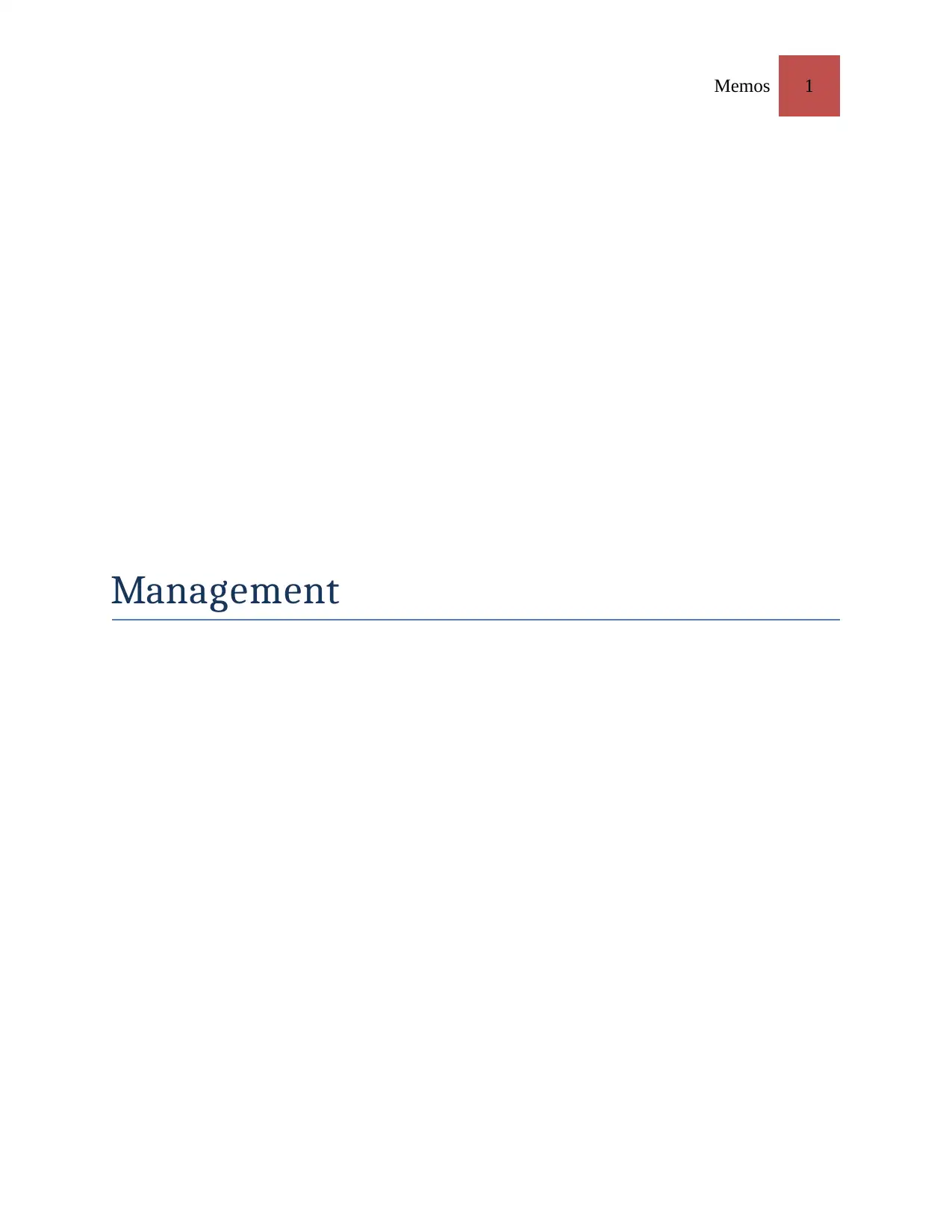
Memos 1
Management
Management
Paraphrase This Document
Need a fresh take? Get an instant paraphrase of this document with our AI Paraphraser

Memos 2
Table of Contents
Case 1...............................................................................................................................................3
Case 2...............................................................................................................................................5
Case 3...............................................................................................................................................7
Case 4...............................................................................................................................................9
References......................................................................................................................................10
Table of Contents
Case 1...............................................................................................................................................3
Case 2...............................................................................................................................................5
Case 3...............................................................................................................................................7
Case 4...............................................................................................................................................9
References......................................................................................................................................10
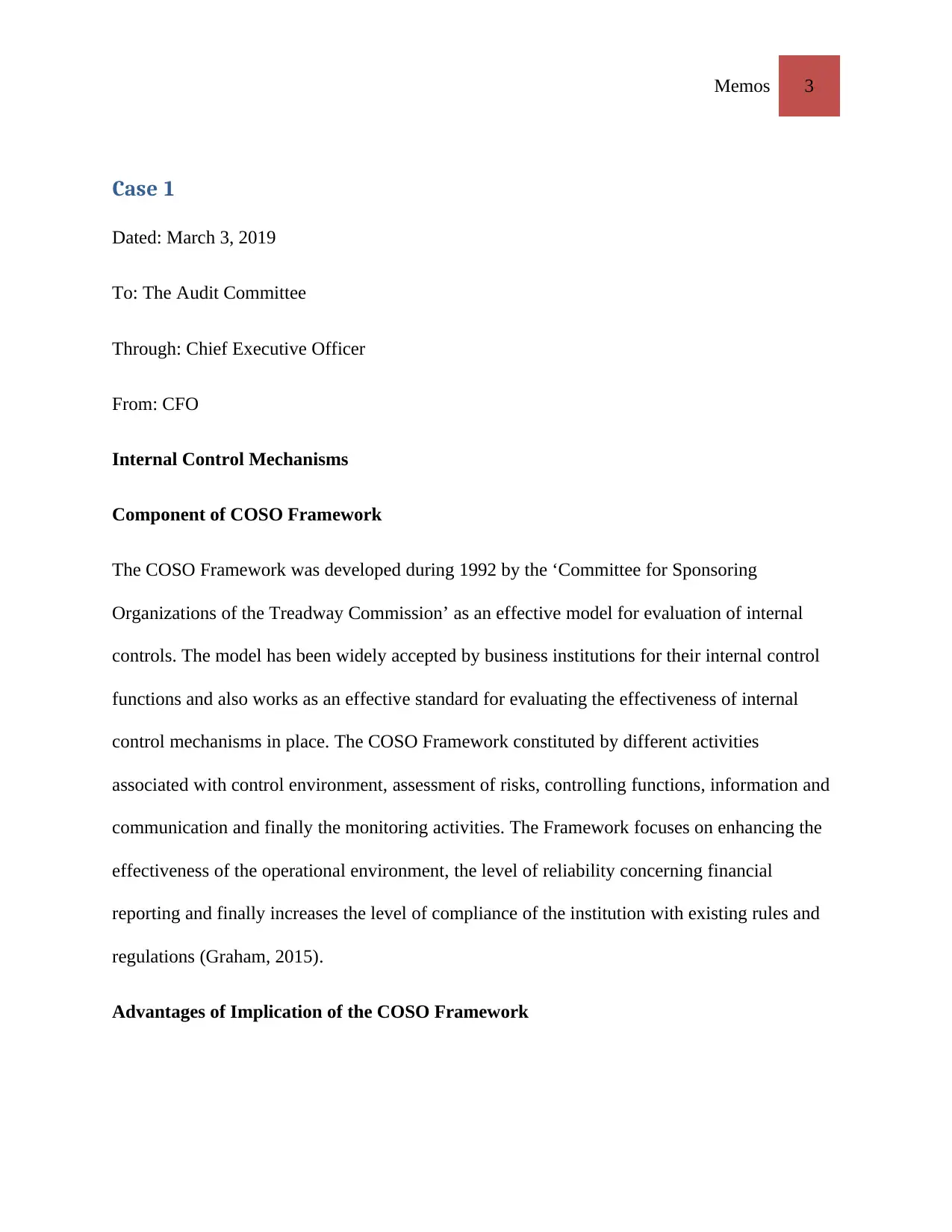
Memos 3
Case 1
Dated: March 3, 2019
To: The Audit Committee
Through: Chief Executive Officer
From: CFO
Internal Control Mechanisms
Component of COSO Framework
The COSO Framework was developed during 1992 by the ‘Committee for Sponsoring
Organizations of the Treadway Commission’ as an effective model for evaluation of internal
controls. The model has been widely accepted by business institutions for their internal control
functions and also works as an effective standard for evaluating the effectiveness of internal
control mechanisms in place. The COSO Framework constituted by different activities
associated with control environment, assessment of risks, controlling functions, information and
communication and finally the monitoring activities. The Framework focuses on enhancing the
effectiveness of the operational environment, the level of reliability concerning financial
reporting and finally increases the level of compliance of the institution with existing rules and
regulations (Graham, 2015).
Advantages of Implication of the COSO Framework
Case 1
Dated: March 3, 2019
To: The Audit Committee
Through: Chief Executive Officer
From: CFO
Internal Control Mechanisms
Component of COSO Framework
The COSO Framework was developed during 1992 by the ‘Committee for Sponsoring
Organizations of the Treadway Commission’ as an effective model for evaluation of internal
controls. The model has been widely accepted by business institutions for their internal control
functions and also works as an effective standard for evaluating the effectiveness of internal
control mechanisms in place. The COSO Framework constituted by different activities
associated with control environment, assessment of risks, controlling functions, information and
communication and finally the monitoring activities. The Framework focuses on enhancing the
effectiveness of the operational environment, the level of reliability concerning financial
reporting and finally increases the level of compliance of the institution with existing rules and
regulations (Graham, 2015).
Advantages of Implication of the COSO Framework
⊘ This is a preview!⊘
Do you want full access?
Subscribe today to unlock all pages.

Trusted by 1+ million students worldwide
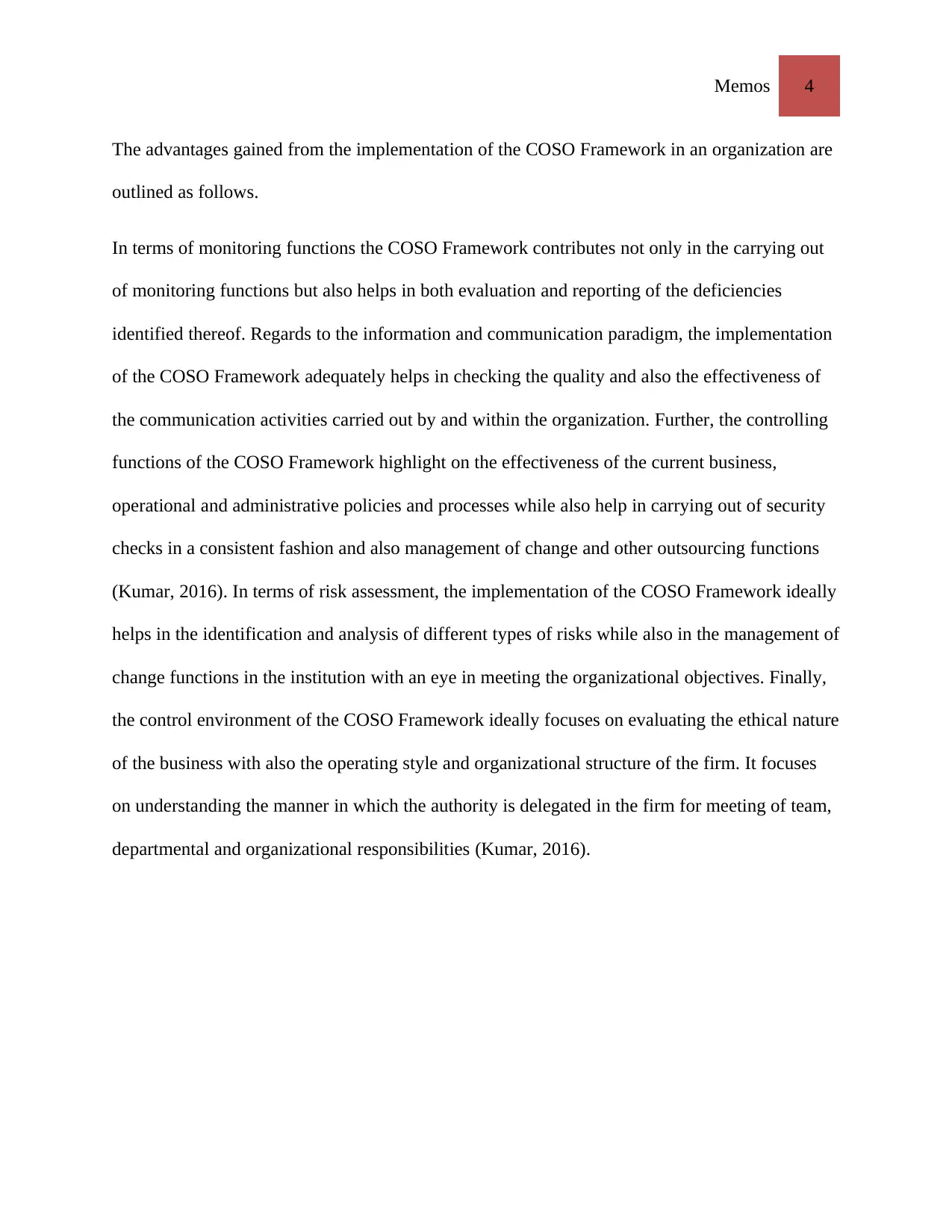
Memos 4
The advantages gained from the implementation of the COSO Framework in an organization are
outlined as follows.
In terms of monitoring functions the COSO Framework contributes not only in the carrying out
of monitoring functions but also helps in both evaluation and reporting of the deficiencies
identified thereof. Regards to the information and communication paradigm, the implementation
of the COSO Framework adequately helps in checking the quality and also the effectiveness of
the communication activities carried out by and within the organization. Further, the controlling
functions of the COSO Framework highlight on the effectiveness of the current business,
operational and administrative policies and processes while also help in carrying out of security
checks in a consistent fashion and also management of change and other outsourcing functions
(Kumar, 2016). In terms of risk assessment, the implementation of the COSO Framework ideally
helps in the identification and analysis of different types of risks while also in the management of
change functions in the institution with an eye in meeting the organizational objectives. Finally,
the control environment of the COSO Framework ideally focuses on evaluating the ethical nature
of the business with also the operating style and organizational structure of the firm. It focuses
on understanding the manner in which the authority is delegated in the firm for meeting of team,
departmental and organizational responsibilities (Kumar, 2016).
The advantages gained from the implementation of the COSO Framework in an organization are
outlined as follows.
In terms of monitoring functions the COSO Framework contributes not only in the carrying out
of monitoring functions but also helps in both evaluation and reporting of the deficiencies
identified thereof. Regards to the information and communication paradigm, the implementation
of the COSO Framework adequately helps in checking the quality and also the effectiveness of
the communication activities carried out by and within the organization. Further, the controlling
functions of the COSO Framework highlight on the effectiveness of the current business,
operational and administrative policies and processes while also help in carrying out of security
checks in a consistent fashion and also management of change and other outsourcing functions
(Kumar, 2016). In terms of risk assessment, the implementation of the COSO Framework ideally
helps in the identification and analysis of different types of risks while also in the management of
change functions in the institution with an eye in meeting the organizational objectives. Finally,
the control environment of the COSO Framework ideally focuses on evaluating the ethical nature
of the business with also the operating style and organizational structure of the firm. It focuses
on understanding the manner in which the authority is delegated in the firm for meeting of team,
departmental and organizational responsibilities (Kumar, 2016).
Paraphrase This Document
Need a fresh take? Get an instant paraphrase of this document with our AI Paraphraser
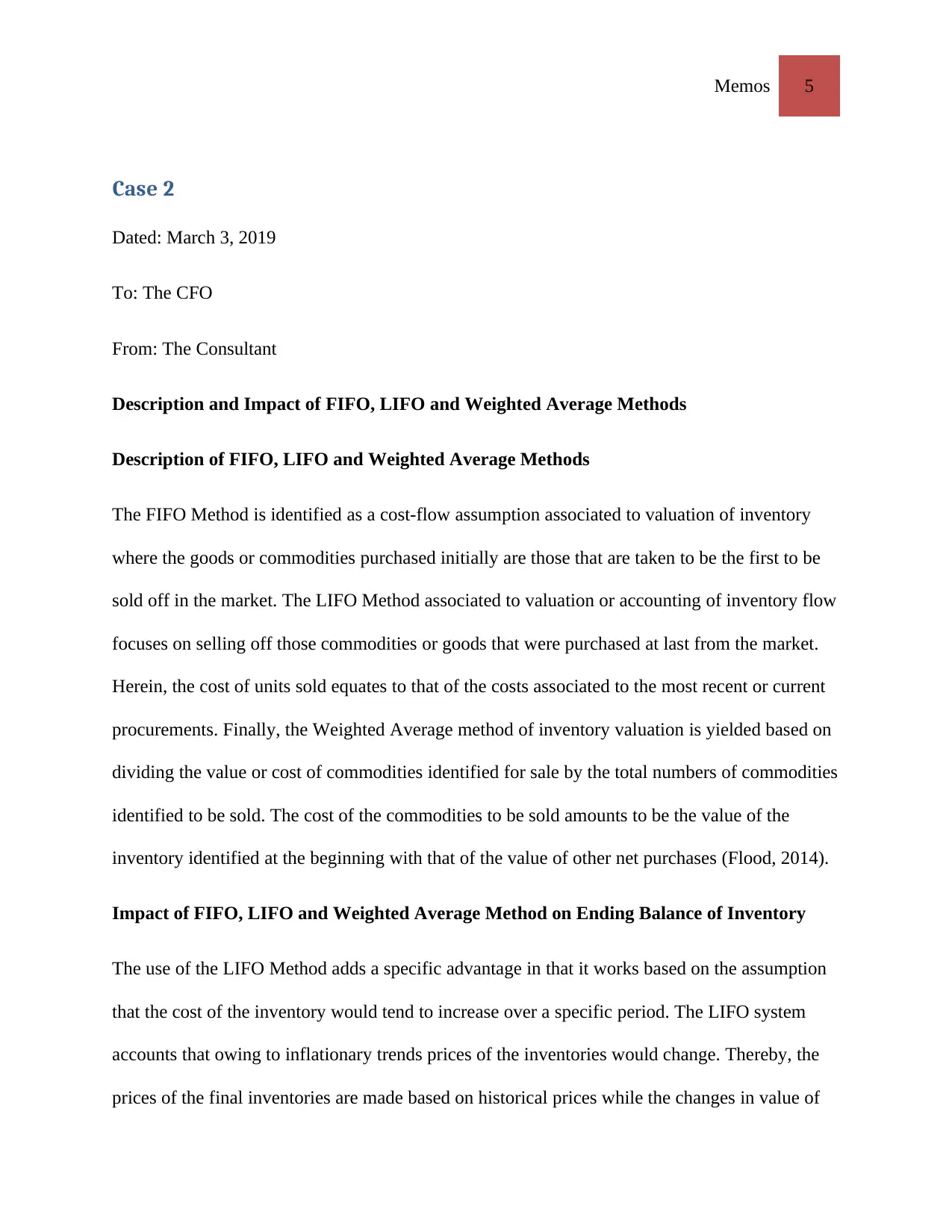
Memos 5
Case 2
Dated: March 3, 2019
To: The CFO
From: The Consultant
Description and Impact of FIFO, LIFO and Weighted Average Methods
Description of FIFO, LIFO and Weighted Average Methods
The FIFO Method is identified as a cost-flow assumption associated to valuation of inventory
where the goods or commodities purchased initially are those that are taken to be the first to be
sold off in the market. The LIFO Method associated to valuation or accounting of inventory flow
focuses on selling off those commodities or goods that were purchased at last from the market.
Herein, the cost of units sold equates to that of the costs associated to the most recent or current
procurements. Finally, the Weighted Average method of inventory valuation is yielded based on
dividing the value or cost of commodities identified for sale by the total numbers of commodities
identified to be sold. The cost of the commodities to be sold amounts to be the value of the
inventory identified at the beginning with that of the value of other net purchases (Flood, 2014).
Impact of FIFO, LIFO and Weighted Average Method on Ending Balance of Inventory
The use of the LIFO Method adds a specific advantage in that it works based on the assumption
that the cost of the inventory would tend to increase over a specific period. The LIFO system
accounts that owing to inflationary trends prices of the inventories would change. Thereby, the
prices of the final inventories are made based on historical prices while the changes in value of
Case 2
Dated: March 3, 2019
To: The CFO
From: The Consultant
Description and Impact of FIFO, LIFO and Weighted Average Methods
Description of FIFO, LIFO and Weighted Average Methods
The FIFO Method is identified as a cost-flow assumption associated to valuation of inventory
where the goods or commodities purchased initially are those that are taken to be the first to be
sold off in the market. The LIFO Method associated to valuation or accounting of inventory flow
focuses on selling off those commodities or goods that were purchased at last from the market.
Herein, the cost of units sold equates to that of the costs associated to the most recent or current
procurements. Finally, the Weighted Average method of inventory valuation is yielded based on
dividing the value or cost of commodities identified for sale by the total numbers of commodities
identified to be sold. The cost of the commodities to be sold amounts to be the value of the
inventory identified at the beginning with that of the value of other net purchases (Flood, 2014).
Impact of FIFO, LIFO and Weighted Average Method on Ending Balance of Inventory
The use of the LIFO Method adds a specific advantage in that it works based on the assumption
that the cost of the inventory would tend to increase over a specific period. The LIFO system
accounts that owing to inflationary trends prices of the inventories would change. Thereby, the
prices of the final inventories are made based on historical prices while the changes in value of
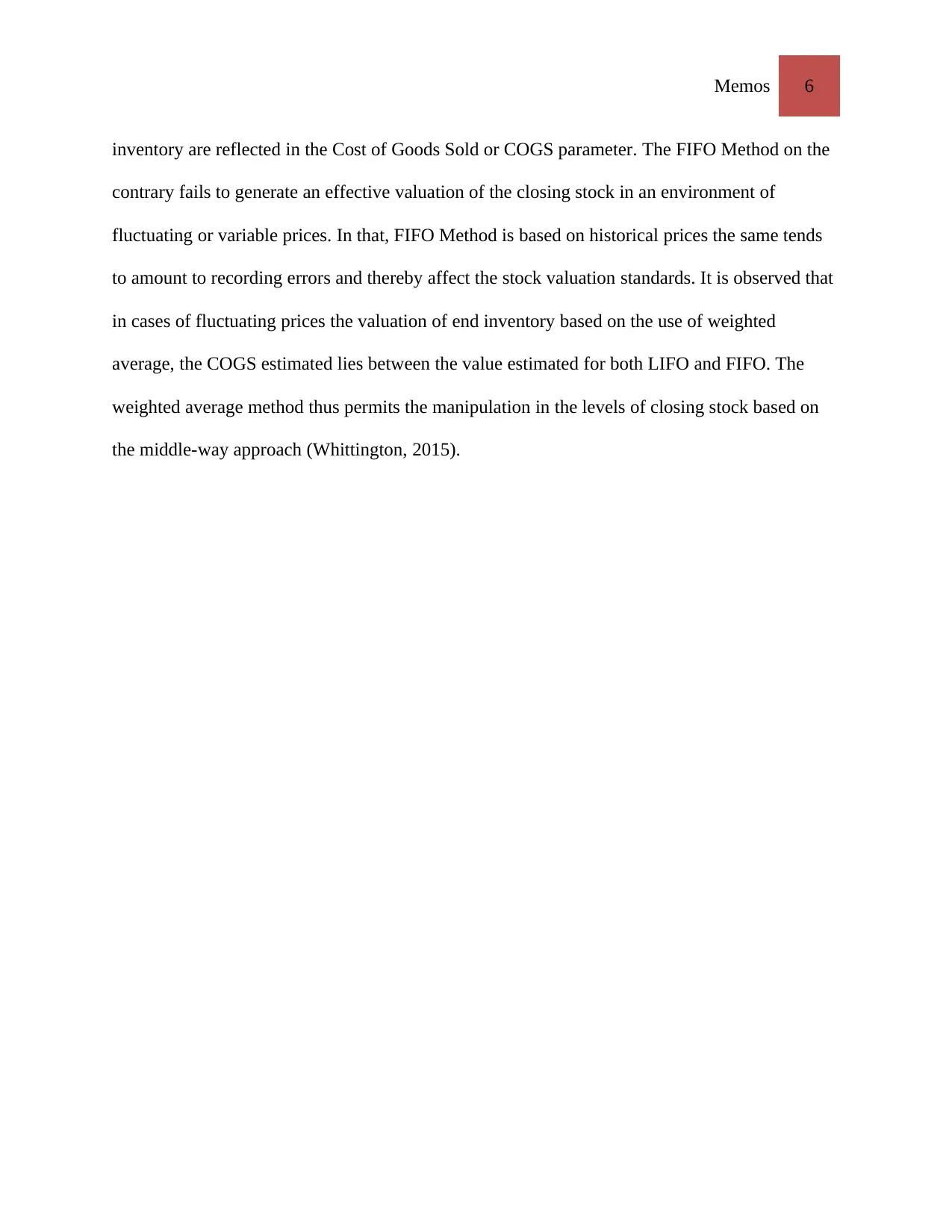
Memos 6
inventory are reflected in the Cost of Goods Sold or COGS parameter. The FIFO Method on the
contrary fails to generate an effective valuation of the closing stock in an environment of
fluctuating or variable prices. In that, FIFO Method is based on historical prices the same tends
to amount to recording errors and thereby affect the stock valuation standards. It is observed that
in cases of fluctuating prices the valuation of end inventory based on the use of weighted
average, the COGS estimated lies between the value estimated for both LIFO and FIFO. The
weighted average method thus permits the manipulation in the levels of closing stock based on
the middle-way approach (Whittington, 2015).
inventory are reflected in the Cost of Goods Sold or COGS parameter. The FIFO Method on the
contrary fails to generate an effective valuation of the closing stock in an environment of
fluctuating or variable prices. In that, FIFO Method is based on historical prices the same tends
to amount to recording errors and thereby affect the stock valuation standards. It is observed that
in cases of fluctuating prices the valuation of end inventory based on the use of weighted
average, the COGS estimated lies between the value estimated for both LIFO and FIFO. The
weighted average method thus permits the manipulation in the levels of closing stock based on
the middle-way approach (Whittington, 2015).
⊘ This is a preview!⊘
Do you want full access?
Subscribe today to unlock all pages.

Trusted by 1+ million students worldwide

Memos 7
Case 3
Dated: March 3, 2019
To: The CFO
From: The Consultant
Advantages and Disadvantages of Shared Services
About Shared Services
Shared services are identified as the conglomeration of different types of business functions that
are carried out by various departments of the business organization. The inclusion of shared
services is observed to be cost-effective in nature in that the same helps in the centralization of
the support functions and back-office operations of the firm for servicing the needs of different
business departments (Bangemann, 2017).
Advantages and Disadvantages of Shared Services
Advantages of Shared Services
-It reduces the costs associated to providing of administrative and support services
-It also helps in close monitoring of service dissemination thereby improving the performance
levels
-It focuses on optimally fulfilling the needs of the core businesses.
Disadvantages of Shared Services
Case 3
Dated: March 3, 2019
To: The CFO
From: The Consultant
Advantages and Disadvantages of Shared Services
About Shared Services
Shared services are identified as the conglomeration of different types of business functions that
are carried out by various departments of the business organization. The inclusion of shared
services is observed to be cost-effective in nature in that the same helps in the centralization of
the support functions and back-office operations of the firm for servicing the needs of different
business departments (Bangemann, 2017).
Advantages and Disadvantages of Shared Services
Advantages of Shared Services
-It reduces the costs associated to providing of administrative and support services
-It also helps in close monitoring of service dissemination thereby improving the performance
levels
-It focuses on optimally fulfilling the needs of the core businesses.
Disadvantages of Shared Services
Paraphrase This Document
Need a fresh take? Get an instant paraphrase of this document with our AI Paraphraser
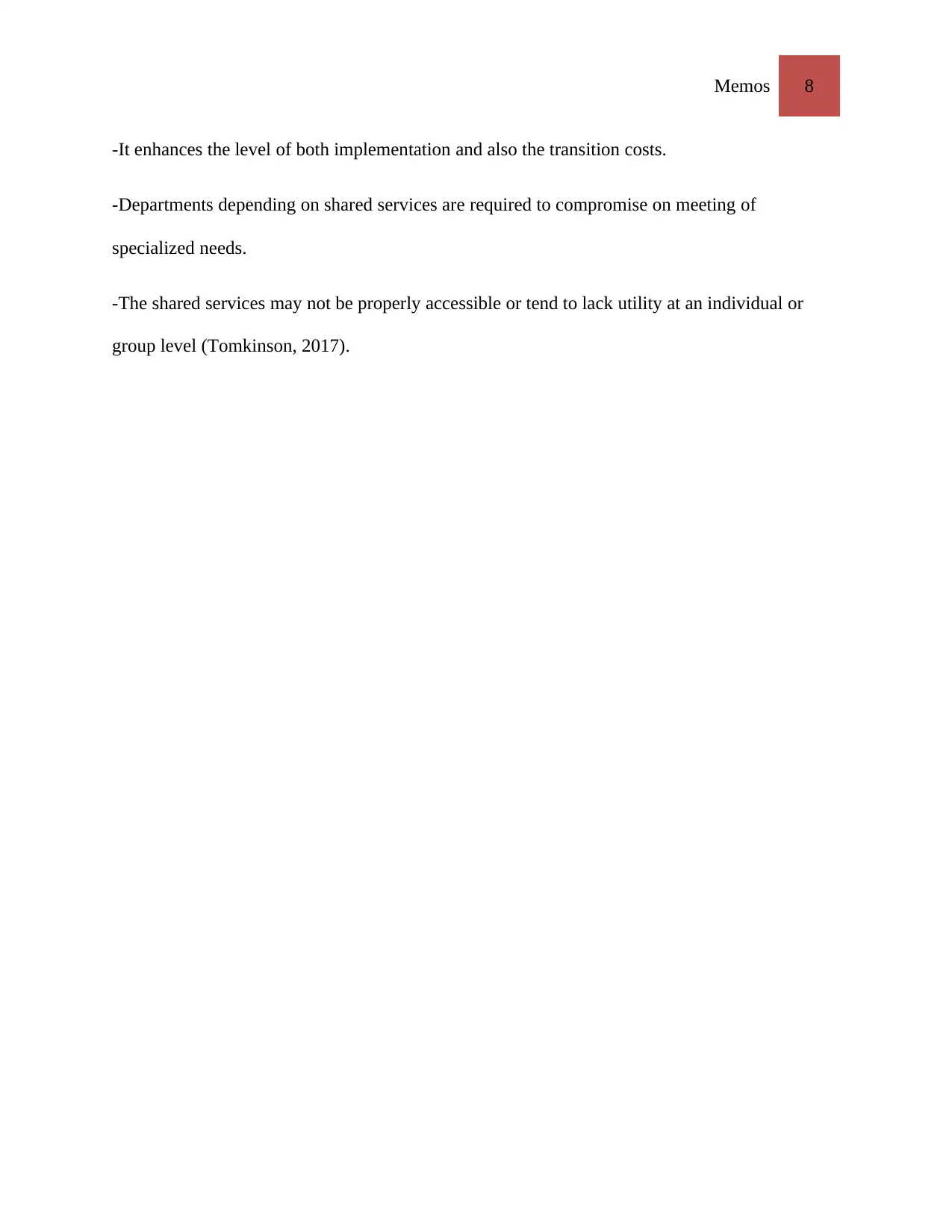
Memos 8
-It enhances the level of both implementation and also the transition costs.
-Departments depending on shared services are required to compromise on meeting of
specialized needs.
-The shared services may not be properly accessible or tend to lack utility at an individual or
group level (Tomkinson, 2017).
-It enhances the level of both implementation and also the transition costs.
-Departments depending on shared services are required to compromise on meeting of
specialized needs.
-The shared services may not be properly accessible or tend to lack utility at an individual or
group level (Tomkinson, 2017).

Memos 9
Case 4
Dated: March 3, 2019
To: The CFO
From: The Consultant
Overview
The volatility in the price structure of the oil prices in the airline industry tends to potentially
affect the level of stock prices of the airline companies in a vice-versa fashion. Airline
companies to protect and also gain the advantage of the price volatility situation tends to use
hedging techniques (Dafir & Gajjala, 2016).
Mitigation of Risk by using Hedging Techniques
In terms of hedging techniques, airline companies can focus on purchasing of large number of oil
contracts in that it helps in mitigation of price changes. Again, airline companies can earn the
benefit of call option wherein the airliners tend to save on future oil costs based on setting of
agreed prices at the current period. Swap Contracts can also be initiated by the airline company
that in turn books the future purchases of oil at a specified rate decided in the current period
(Gong & Cullinane, 2018).
Case 4
Dated: March 3, 2019
To: The CFO
From: The Consultant
Overview
The volatility in the price structure of the oil prices in the airline industry tends to potentially
affect the level of stock prices of the airline companies in a vice-versa fashion. Airline
companies to protect and also gain the advantage of the price volatility situation tends to use
hedging techniques (Dafir & Gajjala, 2016).
Mitigation of Risk by using Hedging Techniques
In terms of hedging techniques, airline companies can focus on purchasing of large number of oil
contracts in that it helps in mitigation of price changes. Again, airline companies can earn the
benefit of call option wherein the airliners tend to save on future oil costs based on setting of
agreed prices at the current period. Swap Contracts can also be initiated by the airline company
that in turn books the future purchases of oil at a specified rate decided in the current period
(Gong & Cullinane, 2018).
⊘ This is a preview!⊘
Do you want full access?
Subscribe today to unlock all pages.

Trusted by 1+ million students worldwide
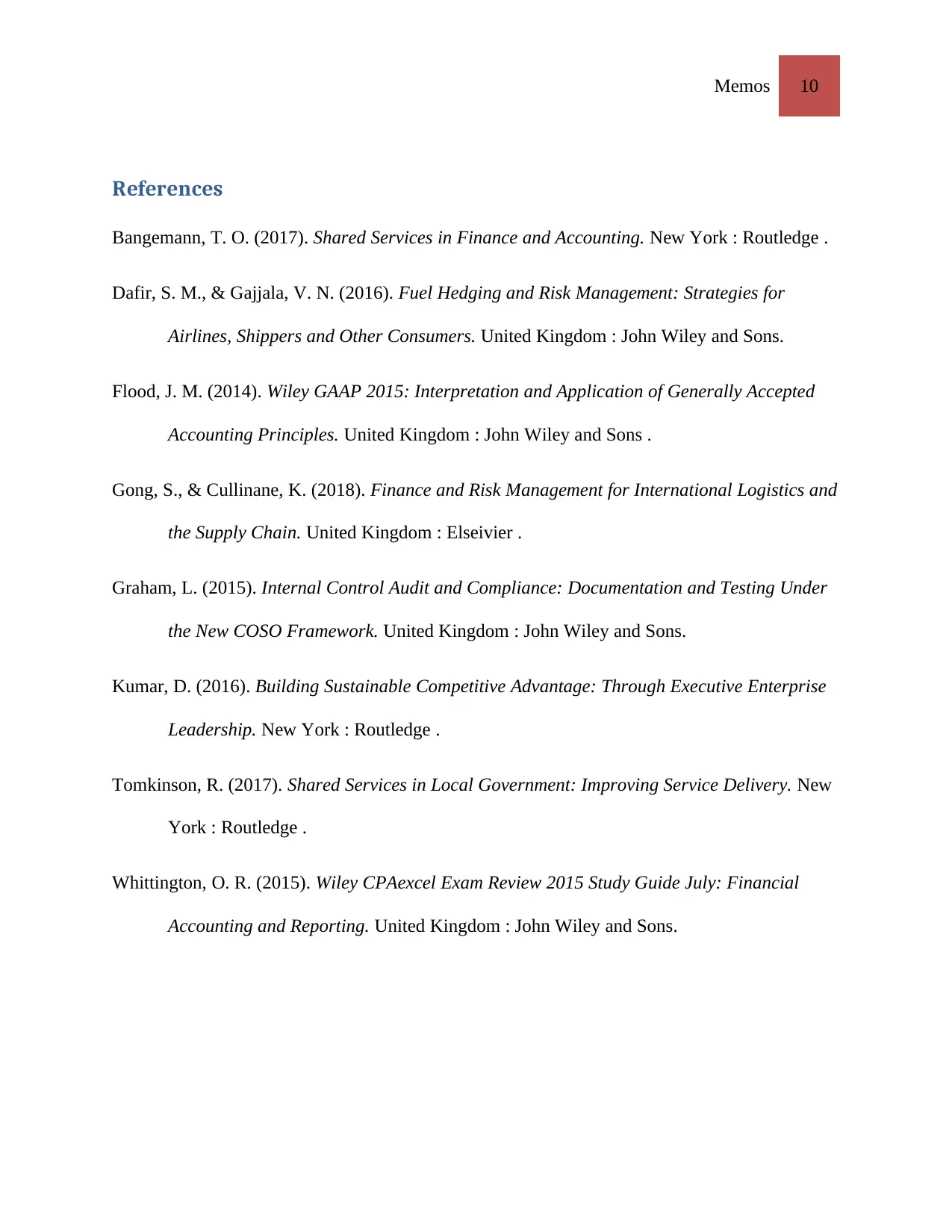
Memos 10
References
Bangemann, T. O. (2017). Shared Services in Finance and Accounting. New York : Routledge .
Dafir, S. M., & Gajjala, V. N. (2016). Fuel Hedging and Risk Management: Strategies for
Airlines, Shippers and Other Consumers. United Kingdom : John Wiley and Sons.
Flood, J. M. (2014). Wiley GAAP 2015: Interpretation and Application of Generally Accepted
Accounting Principles. United Kingdom : John Wiley and Sons .
Gong, S., & Cullinane, K. (2018). Finance and Risk Management for International Logistics and
the Supply Chain. United Kingdom : Elseivier .
Graham, L. (2015). Internal Control Audit and Compliance: Documentation and Testing Under
the New COSO Framework. United Kingdom : John Wiley and Sons.
Kumar, D. (2016). Building Sustainable Competitive Advantage: Through Executive Enterprise
Leadership. New York : Routledge .
Tomkinson, R. (2017). Shared Services in Local Government: Improving Service Delivery. New
York : Routledge .
Whittington, O. R. (2015). Wiley CPAexcel Exam Review 2015 Study Guide July: Financial
Accounting and Reporting. United Kingdom : John Wiley and Sons.
References
Bangemann, T. O. (2017). Shared Services in Finance and Accounting. New York : Routledge .
Dafir, S. M., & Gajjala, V. N. (2016). Fuel Hedging and Risk Management: Strategies for
Airlines, Shippers and Other Consumers. United Kingdom : John Wiley and Sons.
Flood, J. M. (2014). Wiley GAAP 2015: Interpretation and Application of Generally Accepted
Accounting Principles. United Kingdom : John Wiley and Sons .
Gong, S., & Cullinane, K. (2018). Finance and Risk Management for International Logistics and
the Supply Chain. United Kingdom : Elseivier .
Graham, L. (2015). Internal Control Audit and Compliance: Documentation and Testing Under
the New COSO Framework. United Kingdom : John Wiley and Sons.
Kumar, D. (2016). Building Sustainable Competitive Advantage: Through Executive Enterprise
Leadership. New York : Routledge .
Tomkinson, R. (2017). Shared Services in Local Government: Improving Service Delivery. New
York : Routledge .
Whittington, O. R. (2015). Wiley CPAexcel Exam Review 2015 Study Guide July: Financial
Accounting and Reporting. United Kingdom : John Wiley and Sons.
1 out of 10
Your All-in-One AI-Powered Toolkit for Academic Success.
+13062052269
info@desklib.com
Available 24*7 on WhatsApp / Email
![[object Object]](/_next/static/media/star-bottom.7253800d.svg)
Unlock your academic potential
Copyright © 2020–2025 A2Z Services. All Rights Reserved. Developed and managed by ZUCOL.

